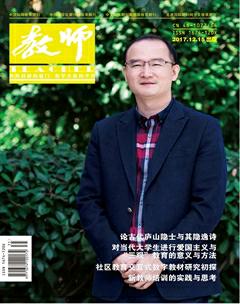A Brief Analysis of the New Translation—comparison Model
佘阿莉
Abstract:With the development of the society,the traditional translation method cant meet the requirements of college English. This paper presents a new English teaching model——New translation-comparison model. Its hoped to provide some useful reference for those who dedicate to English teaching and research.
Key words:new translation-comparison model;assimilation;accommodation
中圖分类号:G641
文献标识码:A
Ⅰ.Introduction
The traditional translation-comparison method,produced in 1930s,is also called conscious contrastive method. It was the product of foreign language teaching in the former Soviet Union which was under the political and economic blockade of the western world. With the development of society,this method has already been eliminated. The latest “College English curriculum requirements”points out that the new teaching model should be “towards personalization and independent learning” especially “establishing the students main position in the process of teaching”. Under this background,I proposes a set of new teaching model——New translation-comparison model which can not only arouse the students, enthusiasm and initiative,but also cultivate the students independent learning ability.
Ⅱ.The concept of New Translation-comparison model and it's the oretical basis
1. Concepts
The traditional translation-comparison method is “ask the students to analyze and compare the structure of the native language and the foreign language to understand the language material”. It is based on the behaviorism and contrastive linguistics. The traditional method attaches great importance to ideological consciousness and the reading ability,but the disadvantage is that it pays too much emphasis on the mutual translation of native language and foreign language, ignoring the training of oracy and dictation ability. Whereas,the new translation-comparison method is comparing the learners language with the target to find out the differences and errors so that the learners language can be improved gradually and its getting closer and closer to the target language. The main principles of the new translation-comparison method are as follows:①The principle of contrasting the learners language (interlanguage) with the target language;②The principle of self-correction;③The principle of constructing actively instead of passive replication;④The principle of independent learning;⑤the principle of detecting the knowledge in social background.endprint
2.The theoretical basis
In Piagets theory, assimilation refers to that people bring perceived and fresh stimulus into the original format so as to achieve the understanding of things. A direct result of assimilation is that it causes the change of format in quantity but it can not lead to the change in quanlity. Accommodation refers to the change of cognitive structure caused by the stimulus of assimilation. It contains two aspects: one is to transform the original format so that it can accept new things;the other is to create a new format to accept new things. The process of accommodation results in a change in quality,leading to the growth and development of cognitive structure. New translation-comparison model involves two aspects of assimilation and accommodation. After the learners translate a discourse,the learners compare and analyze the learnerslanguage and the target language. For those knowledge that is identical or similar to the learners structure,the learners use the principle of assimilation directly and integrate the new information to their original cognitive structure.For those that is different or not consistent with the learnersexisting information,the learners will take the way of accommodation. They reconstruct and transform the original knowledge so as to accept new knowledge.
Ⅲ.The implications for foreign language teaching
1.Students centred
The humanistic psychologist Rodgers thinks that students learning is a learning experience. It takes the growth of students experience as the center and takes the students spontaneity and autotomy as learning motivation. As a result, the goal of education is to help the students change and make the students learn how to learn. The aim is also to cultivate the students to know how to give full play to the role of “free man” and have a unique personality at the same time. The new translation-comparison model attaches great importance to the development of students personality so that students can participate in the whole teaching process actively and“make the English teaching process become a process of helping each student explore the potentiality, develop personality and realize the value of self”. (Ge,2004)
2.Combining language teaching with culture teaching
The social significance of Vygotskys theory of “recent development zones” is that language learning also exists in the specific environment of culture. Learners can learn more about the cultural background of the target language through translation (with books or internet access), and understand the culture and customs and ways of thinking of the target language.endprint
3. To make full use of students spare time
There are a number of students who have not formed a good habit of learning. The learning behavior is still relatively passive in a large extent. The new translation-comparison model can make full use of the students spare time and make them feel it has something to do. And the knowledge obtained after active thinking through translation, comparison and analysis of brain activities is easily remembered. According to the principle of memory, the knowledge obtained in this way is stored more easily in the long memory.
4.Proper use of conscious teaching
From the psychological point of view, its necessary in foreign language learning to explore the language similarity if the mother tongue and the target language are far in typology, which can promote the learners treat their mother tongue more actively. In the translation-comparison model, the teacher guides the students from the discourse to stimulate their interest in language perception and maximize the use of the mother tongue.
Ⅳ.Conclusion
Richards thinks that teaching is an art. The success of teaching depends on the teacher. There is no way in the world that can solve all the problems in the teaching. Good teachers should study the teaching and combine it with the practice and construct teaching theory of their own. In short, this model “reflects the rules of language and language learning.” It is reasonable in theory and feasible in practice. (Chen,2006)
参考文献:
[1]陈 静.大学英语3A教学模式探索[J].外语教学,2006(5):71-73.
[2]葛玲芬.教育心理学在英语教学中的运用[J].外语与外语教学,2004(6):39-41.
[3]教育部高等教育司.大學英语课程教学要求[M].上海:上海外语教育出版社,2007.
[4]罗立胜,何福胜,杨 芳.理工科学生外语学习行为模式的探讨[J].外语与外语教学,2006(5).endprint

